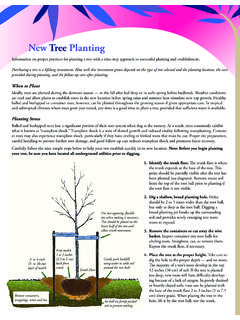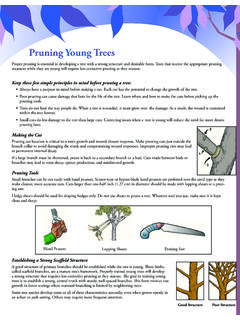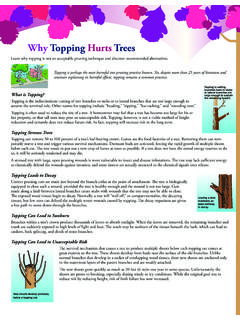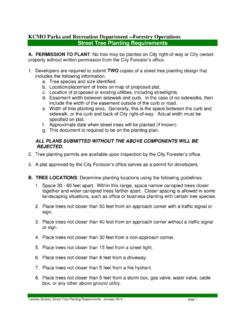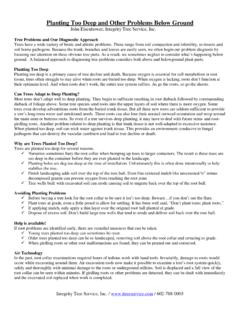Transcription of Avoiding Tree & Utility Conflicts - TreesAreGood.org
1 Avoiding Tr e e & Utility ConflictsMany factors should be considered prior to planting . Here are some helpful hints for tree planting around where to plant a tree is a decision that should not be taken lightly. Many factors should be considered prior to planting . When planning what type of tree to plant, remember to look up and look down to determine where the tree will be located in relation to overhead and underground Utility , we take Utility services for granted, because they have become a part of our daily lives. To ensure us the benefits of reliable, uninterrupted service, distribution systems are required to bring utilities into our homes. These services arrive at our homes through overhead or underground lines carry electricity, data, and communications.
2 Underground Utility lines may also carry those mentioned, plus water, sewer, and natural gas. The location of these lines should have a direct impact on your tree and planting site selection. The ultimate mature height and spread of a tree must fit within the available growing space beneath and alongside the lines. Just as important, the soil area must be large enough to accommodate the particular rooting habits and ultimate trunk diameter of the tree . Proper tree and site selection can provide trouble-free beauty and pleasure for years to come. Overhead LinesOverhead Utility lines are easy to spot, yet often overlooked. Although these lines look harmless enough, they can be extremely dangerous.
3 planting tall-growing trees under or near these lines eventually requires your Utility provider to prune them to maintain safe clearance from the wires. This pruning may result in the tree having an unnatural appearance. Periodic pruning can also lead to a shortened life span for the tree . Trees that must be pruned away from power lines are under greater stress and are more susceptible to insects and disease. Small, immature trees planted today that have the potential to grow into overhead lines can become problem trees in the trees near overhead lines can cause service interruptions when trees contact wires. Children or adults climbing in these trees can be severely injured or even killed if they come in contact with the wires.
4 Proper selection and placement of trees in and around overhead utilities can eliminate potential public safety hazards, reduce expenses for utilities and their customers, and improve landscape LinesTrees consist of much more than what you see above ground. Many times, the root area below ground is larger than the branch spread. Many of the Utility services provided today run below ground. tree roots and underground lines often coexist without problems. However, trees planted near underground lines could have their roots damaged if the lines are dug up for repair. The greatest danger to underground lines occurs during planting . Before you plant, make sure that you are aware of the location of any underground utilities.
5 To be certain that you do not accidentally dig into any lines and risk serious injury or a costly service interrup-tion, call your Utility company or Utility locator service first. Never assume that these Utility lines are buried deeper than you plan to dig. In some cases, Utility lines are very close to the surface. Locating underground utilities before digging is often required by ZonesTrees that grow 60 feet (20 meters) or taller can be used in the area marked Tall Zone. Plant large trees at least 35 feet (11 meters) away from the house for proper root development and to minimize damage to the building(s). These large-growing trees can be planted on streets without overhead restrictions if planting space is sufficient.
6 Street planting sites should be greater than 8 feet (3 meters) and allow for a large root system, trunk diameter, and trunk trees are also recommended for parks, meadows, or other open areas where their large size, both above and below ground, will not be restricted, cause damage, or become a ZonesMedium-sized trees that grow up to 40 feet (12 meters) tall are often used to frame or soften the appearance of structures or create a park-like setting. Appropriate soil spaces are wide planting areas or medians [4 to 8 feet (1 to 3 meters) wide], large planting squares [8 feet (3 meters) square or greater], and other open areas of similar size or larger. Low ZonesThis zone extends 15 feet ( meters) on either side of the wires.
7 Trees with a mature height of less than 20 feet (6 meters) may be planted anywhere within this zone, including street tree plantings under Utility lines. Such trees are also recommen- ded where soil volumes are too limited to support tall or medium zone trees. Some Further SuggestionsPlant evergreen trees in the path of prevailing winter winds to serve as windbreaks. Plantings should be approximately 50 feet (15 meters) or more from the house. Plant deciduous trees (those that drop their leaves in the fall) to maximize shading in the summer. In winter, the bare canopies will allow sunlight to reach the tree Right PlacePlanning before planting can help ensure that the right tree is planted in the right place.
8 Proper tree selection and placement enhance your property value and prevent costly maintenance trimming and damage to your home. For further information on planting and helpful tips on tree selection, refer to ISA s brochures on tree selection and new tree planting . If you have any more questions, please contact your local ISA Certified Arborist or tree care professional, Utility company, local nursery, or county extension illustration indicates approximate tree placement in relation to Utility Placement for Trees Around HomesThis brochure is one in a series published by the International Society of Arboriculture as part of its Consumer Information Program. You may have additional interest in the following titles currently in the series: Avoiding tree and Utility Conflicts Avoiding tree Damage During Construction Benefits of Trees Buying High-Quality Trees Insect and Disease Problems Mature tree Care New tree planting Plant Health Care Proper Mulching TechniquesPalms Pruning Mature TreesPruning Young Trees Recognizing tree Risk Treatment of Trees Damaged by Construction tree Selection and Placement Trees and Turf tree Values Why Hire an Arborist Why Topping Hurts TreesE-mail inquiries.
9 2011 (1998, 2004) International Society of by the International Society of Arboriculture (ISA), a non-profit organization supporting tree care research around the world and dedicated to the care and preservation of shade and ornamental trees. For further information, contact: ISA, Box 3129, Champaign, IL 61826-3129, USA. E-mail inquiries.
